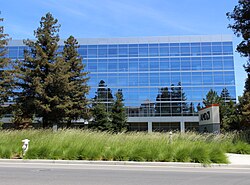
Back AMD Afrikaans إي إم دي Arabic Advanced Micro Devices Azerbaijani Advanced Micro Devices BAN AMD Byelorussian AMD Bulgarian অ্যাডভান্সড মাইক্রো ডিভাইসেস Bengali/Bangla Advanced Micro Devices BS AMD Catalan Advanced Micro Devices Czech
 | |
 Headquarters in Santa Clara, California, in 2020 | |
| AMD | |
| Company type | Public |
| |
| Industry | Semiconductors |
| Founded | May 1, 1969 |
| Founder | Team led by Jerry Sanders |
| Headquarters | , United States |
Area served | Worldwide |
Key people |
|
| Products | |
| Brands | |
| Revenue | |
| Total assets | |
| Total equity | |
Number of employees | c. 26,000 (2023) |
| Website | amd.com |
| Footnotes / references [1] | |
Advanced Micro Devices, Inc. (AMD) is an American multinational corporation and technology company headquartered in Santa Clara, California and maintains significant operations in Austin, Texas. AMD is a hardware and fabless company that designs and develops central processing units (CPUs), graphics processing units (GPUs), field-programmable gate arrays (FPGAs), system-on-chip (SoC), and high-performance compute solutions. AMD serves a wide range of business and consumer markets, including gaming, data centers, artificial intelligence (AI), and embedded systems.
AMD's main products include microprocessors, motherboard chipsets, embedded processors, and graphics processors for servers, workstations, personal computers, and embedded system applications. The company has also expanded into new markets, such as the data center, gaming, and high-performance computing[2] markets. AMD's processors are used in a wide range of computing devices, including personal computers, servers, laptops, and gaming consoles. While it initially manufactured its own processors, the company later outsourced its manufacturing, after GlobalFoundries was spun off in 2009. Through its Xilinx acquisition in 2022, AMD offers field-programmable gate array (FPGA) products.
AMD was founded in 1969 by Jerry Sanders and a group of other technology professionals. The company's early products were primarily memory chips and other components for computers. In 1975, AMD entered the microprocessor market, competing with Intel, its main rival in the industry. In the early 2000s, it experienced significant growth and success, thanks in part to its strong position in the PC market and the success of its Athlon and Opteron processors. However, the company faced challenges in the late 2000s and early 2010s, as it struggled to keep up with Intel in the race to produce faster and more powerful processors.
In the late 2010s, AMD regained market share by pursuing a penetration pricing strategy[3] and building on the success of its Ryzen processors, which were considerably more competitive with Intel microprocessors in terms of performance while offering attractive pricing.[4]
- ^ "AMD 2023 Annual Report (Form 10-K)". U.S. Securities and Exchange Commission. January 31, 2024.
- ^ Ware, Ana (November 20, 2023). "AMD Delivers High Performance, High Efficiency CPUs and GPUs for All HPC Use Cases". HPCwire. Retrieved February 16, 2024.
- ^ "AMD's Extremely Successful Price Strategy Could Burden AMD And Intel Investors Long Term". seekingalpha.com. October 22, 2019. Retrieved August 23, 2024.
- ^ "AMD ascending: How Ryzen CPUs snatched the computing crown from Intel". PCWorld. Retrieved August 23, 2024.